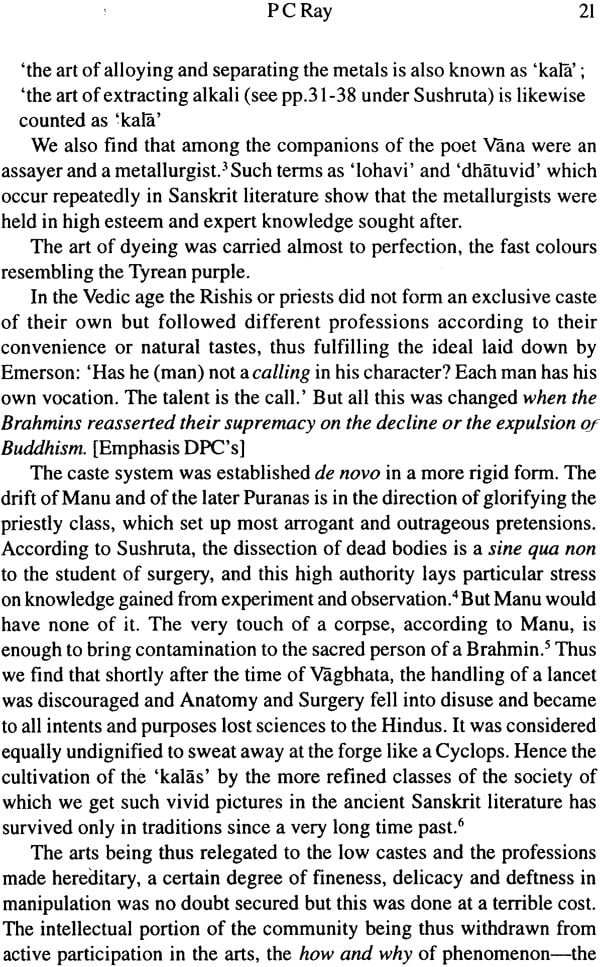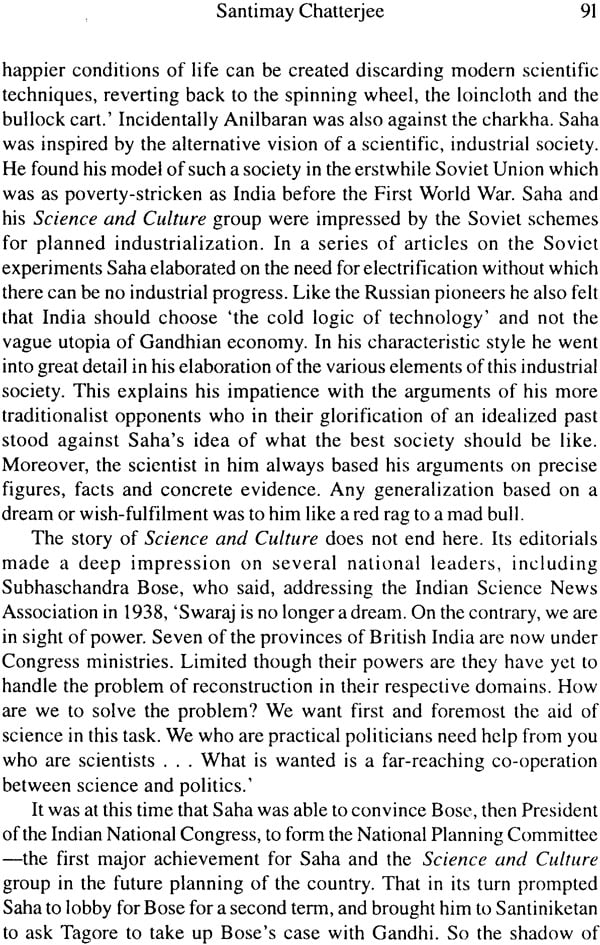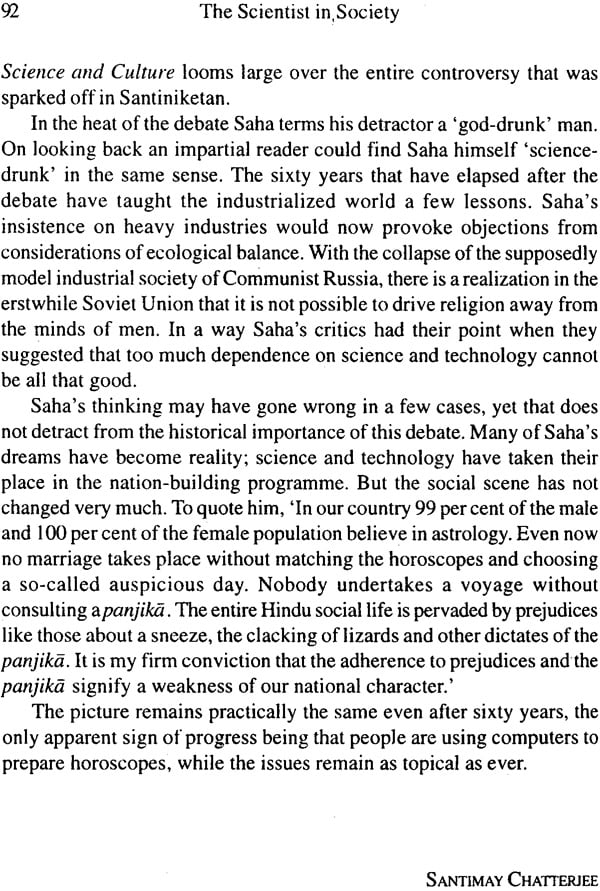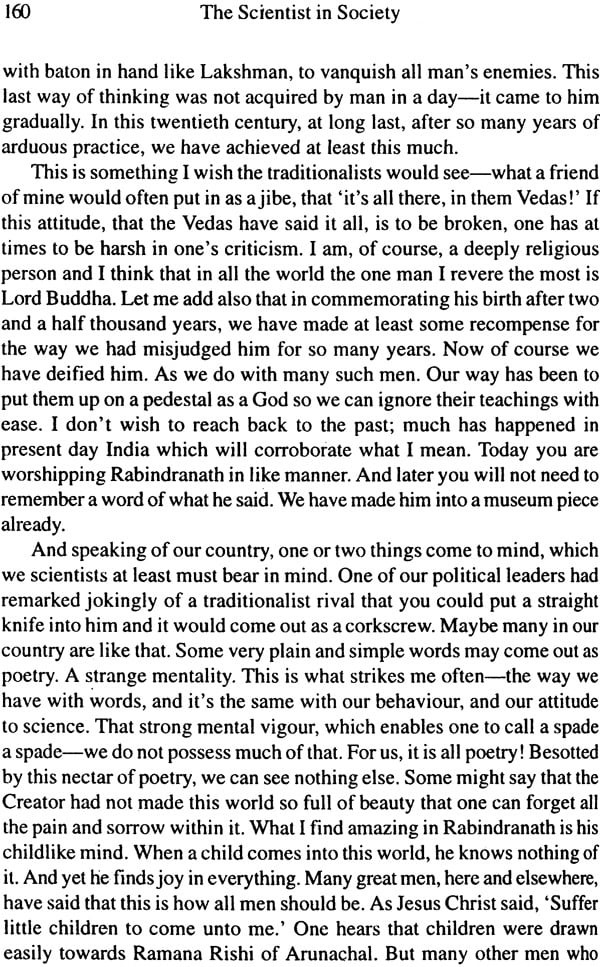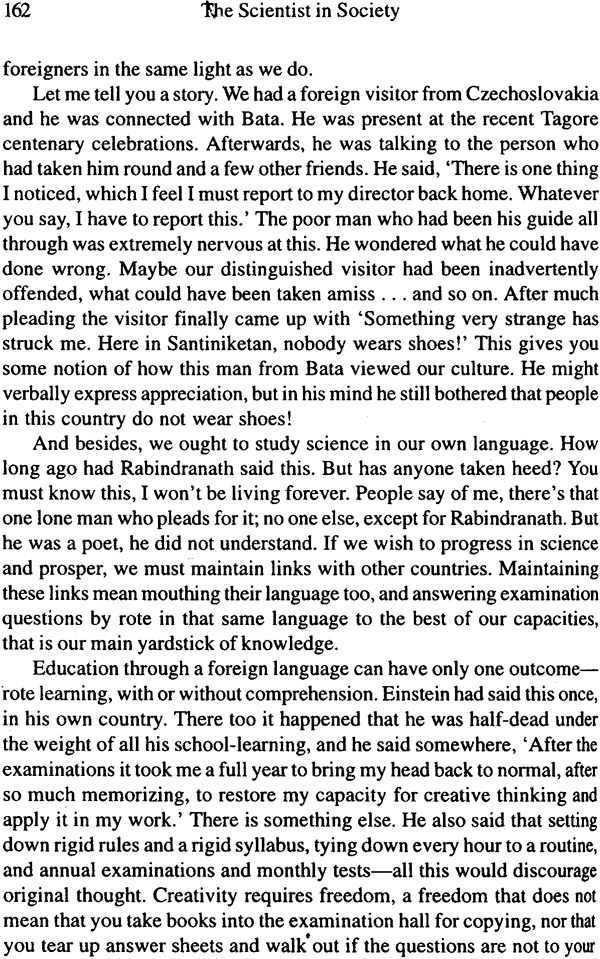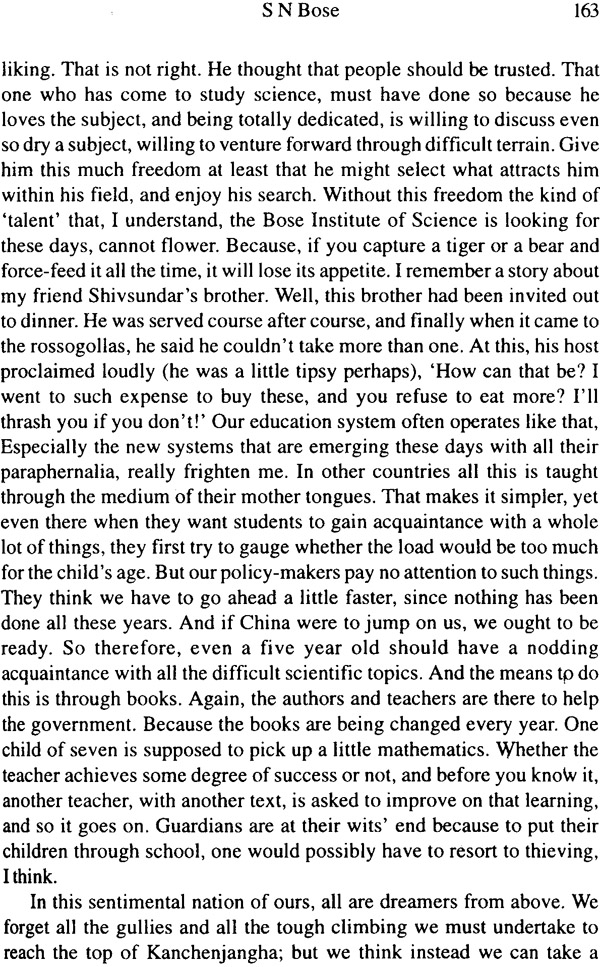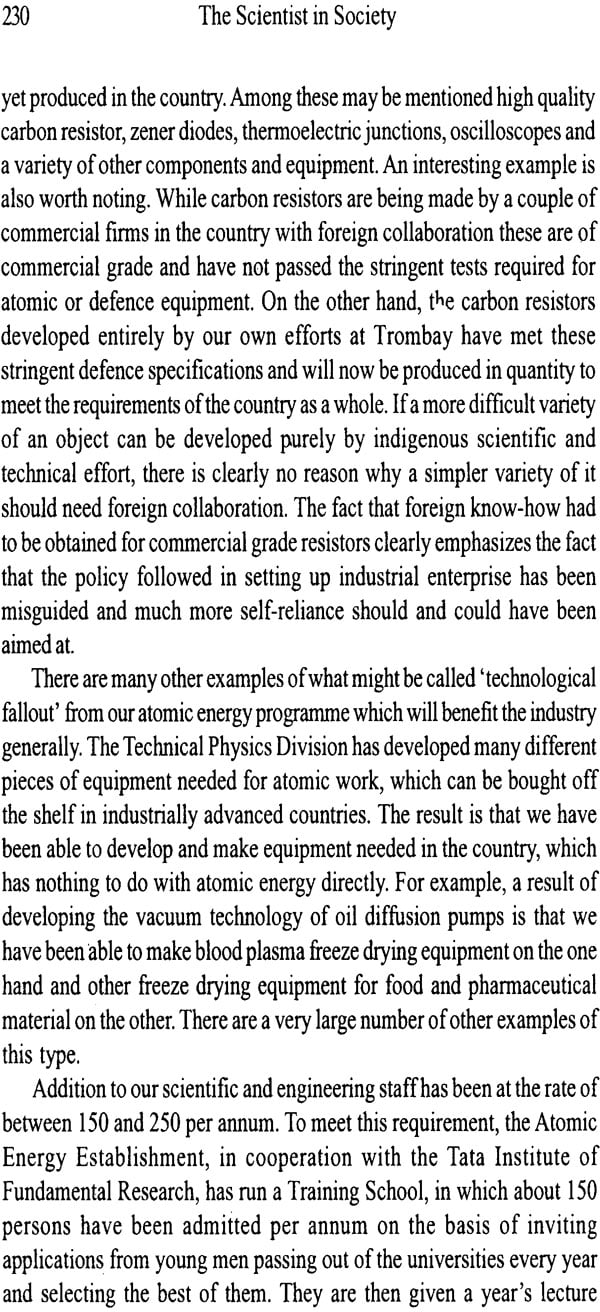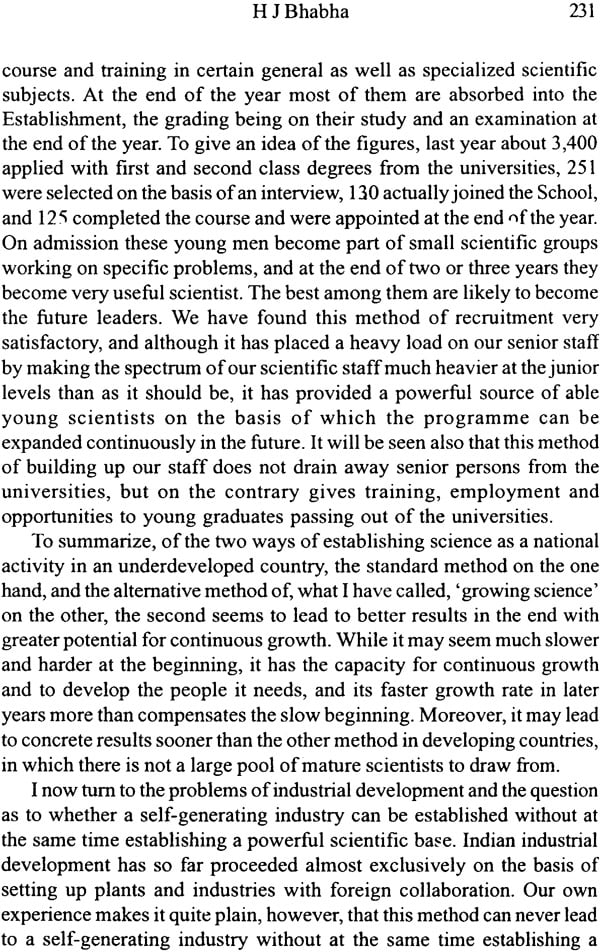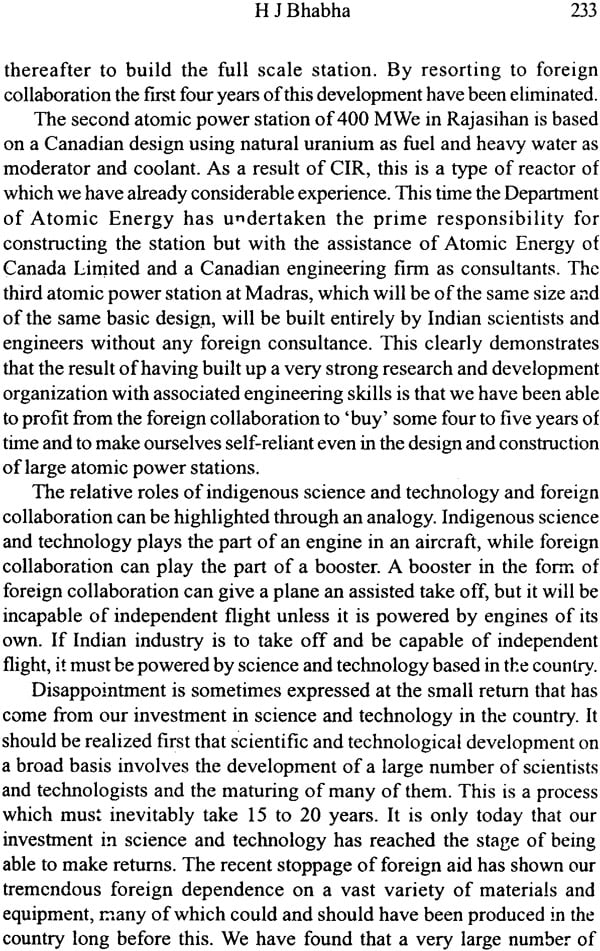
The Scientist in Society
Book Specification
| Item Code: | NAN514 |
| Publisher: | Thema Books, Kolkata |
| Language: | English |
| Edition: | 2010 |
| ISBN: | 9788186017777 |
| Pages: | 248 |
| Cover: | Paperback |
| Other Details | 8.5 inch x 5.5 inch |
| Weight | 270 gm |
Book Description
This collection of essays and addresses-most of them quite inaccessible now, and some of them translated for the first time into English-offers a rare insight into the social concern that the first generation of modern Indian scientists brought to their commitment to science. Even as they sought in the dissemination of the scientific temper the enlightenment of the Indian mind cramped under superstition and obscurantism, their emphasis was on innovation, improvisation, and creativity. The Indian science project, as they conceived it, would be one that could stand on its own, devising its own machinery, and asserting its independence. The six scientists and their modern commentators provide a rich set of readings opening up a fresh view of a project that has been distorted and diluted over the years.
This volume has had a long history. It originated in a conversation with the late Debiprasad Chattopadhyay (1918-93), who helped us define the scope of the selection of essays and addresses, and located for us the opening piece by PC Ray, which had once formed part of his History of Hindu Chemistry but had been later dropped from posthumous editions! The conversation grew out of a sense of frustration at the way in which the 1981 debate over the Statement on Scientific Temper had petered out, allowing obscurantism and uncritical trendiness to take over as the dominant attitudes on the national scene.
The 1981 document 'A Statement on Scientific Temper', released by P N Haksar, Raja Ramanna and PM Bhargava, on 19 July 1981, with Amit Bhaduri, Bipan Chandra, Rajni Patel, Shyam Benegal, K N Raj, and B M Udgaonkar among the signatories, located the Scientific Temper in 'the acceptance, amongst others, of the following premises: (a) that the method of science provides a viable method of acquiring knowledge; (b) that human problems can be understood and solved in terms of knowledge gained through the application of the method of science; (c) that the fullest use of the method of science in everyday life and in every aspect of human endeavour from ethics to politics and economics-is essential for ensuring human survival and progress; and (d) that one should accept knowledge gained through the application of the method of science as the closest approximation to truth at that time, and question what is incompatible with such knowledge; and that one should from time to time re-examine the basic foundations of contemporary knowledge.'
The document described 'the method of science' as 'a regenerative process for collecting information and processing the collected information to create meaningful patterns leading to an ordered understanding of the nature of man himself, his natural and social environment. In this sense, the method of science encompasses all aspects of communicable human knowledge and cuts across all artificial compartmentalization like natural science, social science, applied science, etc.'
The authors of the document did not project the Scientific Temper as a final solution to all problems. As a matter of fact, they warned against 'the simplistic view that through the introduction and pursuit of science and technology, most social problems and contradictions will get automatically resolved. The role of reason is to apply scientific knowledge to problems, to grapple with them through the method of scientific enquiry and to work for social transformation inspired by Scientific Temper.'
The debate sparked off by the document rightly sought to give the 'philosophy' of the document a locus in the ground realities of state power using science ('with most modern technology being intrinsically science-based, it becomes impossible to separate the scientific and technological contents of research; consequently, the argument that science is value-free and technology is the villain doing the dirty job becomes obviously too simplistic') to achieve its class interests, and in the process reducing 'the belief in progress through science' 'to the claim that knowledge becomes more reliable only when it is a product of research in the West.' Taking part in the debate, Vandana Shiva went to the length of charging the signatories to the document of upholding 'prescriptions to distrust one's own experience and beliefs, not in the Cartesian sense of fruitful doubt, but in the colonial sense of blind faith in Western sources of scientific information.'
By the close of the decade, when we took up this project at Thema, and spoke to Chattopadhyay, the Bhopal gas disaster had already taken place, and A Rahman, former Director of the National Institute of Science, Technology and Development, was raising even more fundamental issues : 'The growth of science in India is purely technical and is parallel to the growth of irrationalism and obscurantism. The latter is expressed in diverse ways, such as in regional, linguistic, religious, caste and other similar prejudices. The two parallel developments have created a duality of outlook and divided the society socially and culturally. The social isolation of scientists in the country has also led Indian scientists, while being preoccupied with purely technical work, to uncritically accept ideas, attitudes, outlooks and philosophies of science as well as the values of the commercial and consumer society of Europe and America.
'The vast majority of the people, not being exposed to science, are able to understand its implications, and not being benefited from the gains of development, have started looking at it with considerable antagonism with their set ideas of the tradition in which they are born ...
'Science and technology policy as has been applied in India has increased the gulf between various sections of society ... There are numerous examples of programmes benefiting a tiny fraction of the population at the expense of the vast majority. However, the major problem now is the disasters, short or long term, as a result of technology-based industries. Who, for instance, is responsible for the Bhopal tragedy? The chemicals industry, Union Carbide, the management of the factory, individuals in management or operational staff, the engineers who built the factory? It is difficult to fix the responsibility and nobody is prepared to own it. Scientists say that they work for acquiring knowledge for its own sake, they are searchers of truth, to unravel the mysteries of nature, to find the unifying features in the diversity of phenomena. But when this knowledge creates weapons of destruction which are used to kill people on a large scale or cause disaster, who has the responsibility for the consequences?
At around the same time, for a First World Nobel laureate in medicine and physiology, the moral question had a simple answer: 'There is nothing about being a scientist that should or need deafen one or close one's mind to the entreaties of conscience.
But for Rahman, as well as Swadesh M Mahajan and E C G Sudarshan, the Indian scientist is in a very special situation. Firstly, 'India's entry into contemporary science, apart from the colonial legacy, has taken place when the wider role of science as an instrument of enlightenment to develop new vision and values has been marginalized. And it is increasingly geared to the pursuit of technological innovations, the latter aiming at purely economic objectives to the exclusion of social and human goals. Further, the way economic goals are pursued, the social cost as well as the unfavourable consequences are borne by the vast majority of the people.
Secondly, as Mahajan and Sudarshan point out, the 'condition peculiar to a modern Indian scientist' is a matter of 'a combination of the colonial tradition and the absence of a scientific tradition ... made lethal by a hearty dose of the much-peddled slogan "Science is Universal";' 'helped by an extremely important post-war development in the United States. The phenomenal prestige gained by the scientists due to their success in the Manhattan Project made it possible for them to launch immense scientific projects for which trained manpower was sorely needed ...Thus there was this coincidence of wants, people from the Third World desperate to come, and the institutions in the United States that could definitely use most of them. The situation is vaguely reminiscent of the indentured labourers who constructed huge railroads, with the difference that this time the labourers came begging at America's doors (with their masters and doctoral degrees) and that the work was physically less hazardous.'
The supposed 'Universality' of Science has become more of a cult in the context of 'liberalization' and 'globalization', strengthening the control of the First World scientific establishment on Third World policies. The signs were ominous enough in 1990, when Professor Yash Pal, in his Presidential Address at the seventy-seventh annual session of the Indian Science Congress at Cochin, insisted: 'You cannot have a scientific and technological world or technological society which is dependent for everything it uses on innovations from abroad. If you have such a society it may appear to be a very glittering society for a while but it cannot be non-aligned or self-reliant and the glitter won't last. It will be a dependent society. To the extent it is a dependent society your cultural parameters will be largely defined by the science and technology coming from outside."
The science debate of the eighties was the immediate setting of this volume. It was Chattopadhyay who drew our attention to the agenda of giving modern science a cultural and indigenous locus in India that was part of the scientific temper of the first generation of modern scientists in India-the generation of Ray, Raman, Mahalanobis, Saha, Bose and Bhabha. Chattopadhyay's death in 1993 temporarily dislocated our project.
We return to the project at the close of the nineties in the midst of yet another science debate-over Sokal's 'hoax'. The Scientist in Society becomes more relevant at this juncture, when Alan Sokal and his supporters take the initiative of defending 'the basic epistemology of inquiry' against the anti-science tendencies growing in the Left as part of its justified resistance to a science turned into a tool in the hands of a State led by narrow class interests. The basic texts, most of them quite inaccessible now (some of them translated into English for the first time), and the commentaries that accompany them, should give readers an insight into an Indian science project with a strong humanist and social orientation that has been diluted and distorted beyond recognition over the years.
This collection brings together a few representative articles and speeches by six outstanding Indian scientists of world renown- P C Ray, M N Saha, S N Bose, C V Raman, P C Mahalanobis and H J Bhabha-introduced by scientists and science historians of a later generation. In the presentations no rigid pattern is followed. Thus D P Chattopadhyay tells us how P C Ray in his History of Hindu Chemistry tried to answer the two questions: 'What infused real vitality into scientific activities in ancient India?' and 'What inhibited their growth and caused their eventual decline?' Ray unfolded in his History of Hindu Chemistry 'a forgotten chapter in the history of the intellectual development of the Indian people, namely, the cultivation of experimental science.' Experiment and observation are direct products of a fruitful combination of the hand and the brain. This connection, which infused vitality in the science of ancient India, was snapped, according to Ray's brilliant analysis, by the 'entrenchment of caste within society, with the disastrous degradation of the social status of the technicians, craftsmen and other manual workers.' He could locate in the caste system itself the real cause of the decline of the scientific spirit of India. Ray was a great exponent of the scientific temper, its development and sustenance, not only amongst scientific workers but also among common people. He was convinced that science could flourish only if the spirit of inquiry found its roots in the minds of a people.
Chattopadhyay offers a relevant chapter from Ray's History of Hindu Chemistry, which gives in much greater detail Ray's method of analysis and his arguments in support of his hypothesis.
J C Bose, Ray's illustrious contemporary and a remarkable scientist, combined in himself-quite uniquely-both experimental and theoretical sciences. But his interest did not go beyond the laboratory. Ray, on the other hand, could easily attract the attention of two of his youngest and most brilliant students by the straight and simple way he had of putting his ideas across. Saha and Bose found in Ray the qualities of a Guru. The minds of the three converged, especially when it came to defending the scientific temper.
It may be of interest to note what Ray, who was invited by Sir Asutosh Mukherjee, the Vice-Chancellor of Calcutta University, to take charge of teaching and research in chemistry in the newly established University College of Science, had written about Saha, Bose and Raman in his Autobiography:
The discriminating eye of Asutosh Mookherjee was not slow to recognize that J C Ghosh, J N Mukherjee, M N Saha and S N Bose would each and all make a name for himself if suitable opportunities were afforded them! ...
Although as yet scientists in posse, there was something indescribable in their [Saha and Bose] character which drew me to them. The bond existing between them and me was as subtle as that of chemical affinity...
My young colleague, Professor Raman of Raman effect[written before the award of the Nobel Prize], is a host in himself. Suffice it to say that if this temple of science has produced only a Raman and nothing else, it will have amply justified the high expectation formed by its Founder.
The chemical affinity to which Ray so fondly referred and which bound Saha and Bose to him provided all three of them with the strongest desire to promote, defend and sustain the scientific temper against heavy odds.
In his article on 'Defending the Scientific Temper', D P Chattopadhyay writes: 'Among the talented students of Presidency College who are indebted to Ray for their early initiation in modern science, Meghnad Saha appears to be a very prominent one. He carried forward not only Ray's defence of science as a value in itself, but also the superb insight of Ray into the relation between science and society. For this Saha was to confront literally a barrage of attacks from the champions of Vedic orthodoxy.'
Anilbaran Roy, the Pondicherry-based philosopher, was one such champion. He could hardly fathom the depth of Saha's knowledge and perception of Vedic literature. Saha chose to take time off his scientific pursuits and argue the case of the scientific temper against Roy, the object being to silence him and critics of his ilk once for all. Presumably, the indiscrimination he had faced early in his life still rankled, and he was keen to prove that such indiscriminations were not enjoined by the Shastras.
That an apparently calm and composed Bose, 'deeply involved in mathematical exploration,' could be so vehement in his defence of the scientific temper was proved when he came out with an extempore rejoinder to a speech 'full of hyperboles about the spiritual heritage of the country,' made by the then Vice-Chancellor, University of Calcutta, on the occasion of the celebration of the centenary of Tagore's birth. The setting up of the Bangiya Bijnan Parishad, together with the publication of Jnan O Bijnan, a regular periodical aimed at the popularization of science, were products of Bose's passionate zeal to use the mother tongue as medium of instruction, and to disseminate the message of science amongst the masses. Earlier Rabindranath Tagore and Prafullachandra Ray, and earlier still Ishwarchandra Vidyasagar upheld a similar attitude both in practice and in their writing.
Saha was a colourful personality whose interests covered diverse areas beyond science. He saw to it that something tangible was achieved in every field in which he took interest. 'Saba's passionate defence of manual work and his emphasis on the need for unity of head and hand as an essential precondition for scientific development is reminiscent of the teaching of PC Ray,' writes Chattopadhyay. In Ray's view, the caste system completely snapped the connection between the hand and the brain. And that is how he explained why the material culture of India lagged behind that of the developed nations.
Saha's interest in floods began with his involvement in relief operations for flood-stricken people along with Ray. He came to set up a river training institute and worked out a laboratory model of the Damodar river. The upshot was the recommendation for the construction of a dam on the river and the establishment of the DVC. He did not stop at that. He contributed a series of articles to Science and Culture to make the people and those in authority conversant with the problem of flood and its control.
One is struck with wonder to discover that Saha had at his fingertips the latest archaeological findings about early civilizations. He wrote several authoritative articles on the Harappa-Mohenjodaro findings and the Indus Valley Civilization.
When he came to take up his project aimed at reforming the Indian calendar, he faced the opposition of traditional Indian calendar makers who asserted that the Hindu system was based on spiritual knowledge and hence must be right. Saha was prepared to accept it only if their calculations of important dates of, say, eclipses and equinoxes, agreed with the astronomical calculations. As a matter of fact, they do not. Saha came out with an elaborate exposure of the errors in the traditional Hindu almanac.
His exposure of the claims of infallibility made for the Vedas was equally penetrating. R C Dutt, the erudite scholar, had already forcefully argued that the mention of the four castes in the Rgveda was a much later interpolation. Saha referred to Dutt to bolster his case which was so formidable that his critics assigned him a place in hell! Saha found it quite acceptable for he was convinced that scientists like him who had already reached there must have by then made hell a liveable place, in many ways more comfortable than heaven. Saha agreed that ancient Indian culture was in no way inferior to other contemporary cultures, but his critics were unable to answer his pointed question as to whether a superior culture in an earlier age necessarily retained its superiority for ever.
Raman and Ray were for a length of years colleagues in the University, and he seems to have been touched by the same concern that brought Ray, Saha and Bose together, in their campaign against the forces and attitudes that stood in the way of the dissemination of a scientific temper, a general scientific awareness, and the development of science in general, in India. Raman might not have been aware of their writings and speeches, most of which were in Bengali. Raman was almost always closeted to the laboratory, and whenever he was out of it, it was only to deliver a scientific talk. He was a great master in the art of making the most abstruse subjects accessible to the general public. In fact, he was fully conscious of this responsibility which he used to carry out meticulously. It appears that he hardly ever revealed his mind as to the social functions of science and the extent to which the scientist should be socially committed. It was in his convocation address delivered at I IT, Madras, on 30 July 1966 that Raman revealed his mind quite extensively. He said:
Nature is the supreme artist; she creates forms of beauty, loveliness and colour, unsurpassable, and this has been from the beginning of time ... she is the inspiration not only of artists, painters, sculptors and engineers, but also as to men of science.
Raman, lover of nature and scientist, examined the colours of natural objects-flowers, fruits, leaves, wings of birds, butterflies, etc.-and offered scientific explanation of the origin of such colours.
In the convocation address referred to above, he was in a relaxed mood and gave his views on education, science, science policy, technical progress and the need for self-reliance:
I think one of the things that all Indians should learn is fearless independent thinking. This is the quality which is very essential and the absence of which, if I may venture to say so with all deference, is what stands today in the path of Indian progress…
Borrowing money from abroad for doing anything is bad enough. But what about borrowing knowledge, experts and so on? This kind of helplessness should be ruthlessly uprooted from our minds. It is better to work with the most inefficient and useless equipment of ours than to shine in borrowed feathers, better to work on problems with our slender resources…
Let me express here forcefully my conviction that no country can become industrially great without a foundation of real knowledge...
Science comes first and technology afterwards.
Taking his stand on this attitude, Raman deprecated the misuse of science in warfare. He found the spectacular ascent on the moon somehow related to militarism. If scientific knowledge is not for human good but for the annihilation of man and human achievements, what worth is that knowledge?
Exhorting the students to self-reliance, Raman said, 'When I got my Nobel Prize, I had hardly spent Rupees two hundred on my equipment. See my Physiology of Vision. All the equipment with which I worked for this book is here in my table drawer, devised by me.' While opening a laboratory, he asked cryptically: 'Where are the brains to put into this magnificent building? Remember, radium was discovered in a tin shed.
Contents
| Introduction | 1 |
| PC Ray | 9 |
| Knowledge of Technical Arts and Decline of Scientific Spirit | 20 |
| Then and Now | 25 |
| C V Raman | 36 |
| The Scientific Outlook | 48 |
| The IIT Convocation Address | 52 |
| Mahalanobis and the Concept of Statistics as a Key Technology | 66 |
| Statistical Methods in National Development | 71 |
| Modern Science and Hindu Religion: A Dialogue between M N Saha and Anilbaran Roy | 86 |
| A New Philosophy of Life | 93 |
| Rejoinder | 97 |
| Rejoinder to the Rejoinder: 1 | 107 |
| Rejoinder to Rejoinder: 2 | 117 |
| Rejoinder to Rejoinder: 3 | 132 |
| Rejoinder to Rejoinder: 4 | 137 |
| Rejoinder | 145 |
| Conclusion | 148 |
| S N Bose | 155 |
| Incidentally | 159 |
| The Scientist's Plea | 167 |
| Education and Science | 173 |
| H J Bhabha | 181 |
| Peaceful Uses of Atomic Energy | 194 |
| The Role of Science and Technology in Producing an Integrated World | 205 |
| The Role of Atomic Energy in Asia | 210 |
| Science and the Problems of Development | 216 |
Sample Pages

